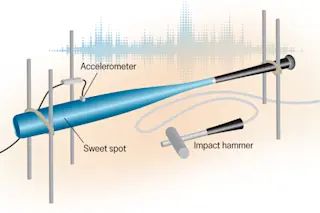Anyone who has ever hit a baseball off the wrong part of the bat knows the shot of pain that courses through your hands. Now, thanks to acoustics engineer Daniel Russell of Pennsylvania State University, that unpleasant jolt could become a relic of the game’s past.
Russell, who has been devising baseball-centric experiments for years, recently helped solve the physics mystery at the heart of the infamous sting. Nearly a decade ago, baseball equipment manufacturer Marucci Sports put a vibration damper inside its aluminum bats to eliminate the pain, but the technology was not working as well as hoped, so the company recruited Russell.
After interviewing several college players, Russell learned they all felt pain in the same spot: the fleshy tissue between the thumb and forefinger in the upper hand of their grip. They all held the bat in roughly the same place, so Russell analyzed the corresponding region ...















